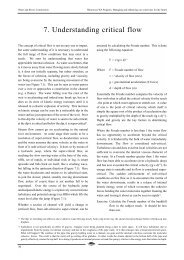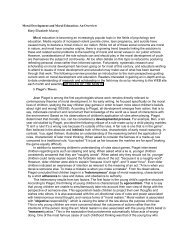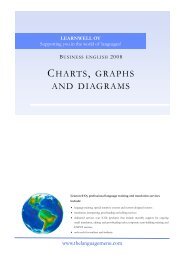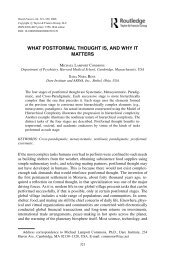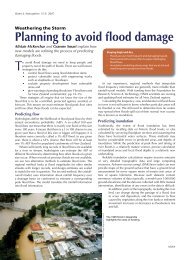Critique of Levinson's theory in relation to women
Critique of Levinson's theory in relation to women
Critique of Levinson's theory in relation to women
Create successful ePaper yourself
Turn your PDF publications into a flip-book with our unique Google optimized e-Paper software.
Journal <strong>of</strong> Adult Development, Vol. 5, No. 1, 1998<br />
The Impact <strong>of</strong> 'the Dream' on Women's Experience <strong>of</strong><br />
the Midlife Transition<br />
Lynette E. M<strong>in</strong>ter1 and Curtis A. Samuels1,2<br />
Daniel <strong>Lev<strong>in</strong>son's</strong> claim for the universality <strong>of</strong> age-l<strong>in</strong>ked periods is considered highly controversial<br />
consider<strong>in</strong>g that his <strong>theory</strong> evolved from a study consist<strong>in</strong>g <strong>of</strong> males only. Theories<br />
relat<strong>in</strong>g <strong>to</strong> <strong>women</strong>'s development, particularly at midlife, are somewhat scarce and restricted.<br />
Us<strong>in</strong>g <strong>Lev<strong>in</strong>son's</strong> <strong>theory</strong> <strong>of</strong> adult development as a framework, the present study retrospectively<br />
exam<strong>in</strong>ed "the Dream" and its impact on <strong>women</strong>'s psychological health and adjustment<br />
<strong>to</strong> the Midlife Transition. Three hundred midlife <strong>women</strong> completed a questionnaire exam<strong>in</strong><strong>in</strong>g<br />
Dream Status, Dream Content, Dream Success, and the psychological health variables,<br />
depression, anxiety, self-esteem, and life satisfaction. Dream Success was significantly related<br />
<strong>to</strong> psychological health on dimensions <strong>of</strong> well-be<strong>in</strong>g and composure, and <strong>in</strong>terest<strong>in</strong>g changes<br />
were observed <strong>in</strong> Dream Content across the early and current Dream. Our f<strong>in</strong>d<strong>in</strong>gs revealed<br />
that, despite the overall greater complexity <strong>of</strong> <strong>women</strong>'s Dreams, <strong>Lev<strong>in</strong>son's</strong> <strong>theory</strong> is largely<br />
applicable <strong>to</strong> <strong>women</strong>'s development.<br />
KEY WORDS: "The Dream"; <strong>women</strong>; midlife transition; developmental trajec<strong>to</strong>ry.<br />
INTRODUCTION<br />
Developmental psychologists have traditionally<br />
focused on childhood as the primary period <strong>of</strong> development.<br />
Freud believed the personality <strong>to</strong> be<br />
more or less determ<strong>in</strong>ed by age 5 and consequently<br />
regarded adulthood as a time <strong>in</strong> which early unconscious<br />
conflicts were reenacted, rather than as a time<br />
<strong>of</strong> further development (Lev<strong>in</strong>son, Darrow, Kle<strong>in</strong>,<br />
Lev<strong>in</strong>son, & McKee, 1979). Beyond adolescence,<br />
there was little recognition <strong>of</strong> growth as a possibility<br />
and, until recently, adult life was viewed primarily <strong>in</strong><br />
terms <strong>of</strong> its problems, with an emphasis on ag<strong>in</strong>g and<br />
decl<strong>in</strong>e.<br />
Adult development has become a rapidly grow<strong>in</strong>g<br />
field <strong>of</strong> research and <strong>theory</strong>, and recent theorists<br />
have adopted life-span perspectives which challenge<br />
1Department<br />
<strong>of</strong> Psychology, University <strong>of</strong> New England, Armidale,<br />
New South Wales 2351.<br />
2Correspondence should be directed <strong>to</strong> Dr. Curtis A. Samuels, Department<br />
<strong>of</strong> Psychology, University <strong>of</strong> New England, Armidale,<br />
New South Wales, Australia 2351.<br />
old assumptions and which view change and development<br />
as be<strong>in</strong>g not only possible, but predictable<br />
(Baltes, 1987). The years between 18 and 50 are now<br />
considered the time when maximum opportunity and<br />
capacity are unfold<strong>in</strong>g (Sheehy, 1976).<br />
Erikson (1950) was the first <strong>to</strong> make the life cycle<br />
a clear and popular concept. However, <strong>to</strong>gether<br />
with Jung, Erikson provided the <strong>in</strong>spiration for<br />
Lev<strong>in</strong>son. Lev<strong>in</strong>son proposed that just as there are<br />
basic pr<strong>in</strong>ciples govern<strong>in</strong>g development <strong>in</strong> childhood<br />
and adolescence, there are sequential periods, eras<br />
and developmental tasks that adults progress through<br />
which <strong>in</strong>fluence the character <strong>of</strong> their life at various<br />
po<strong>in</strong>ts along the life path (Lev<strong>in</strong>son et al., 1979). Unlike<br />
Erikson, however, Lev<strong>in</strong>son viewed his stages as<br />
be<strong>in</strong>g heavily constra<strong>in</strong>ed by age and was very specific<br />
about the duration and tim<strong>in</strong>g <strong>of</strong> the periods.<br />
<strong>Lev<strong>in</strong>son's</strong> Theory <strong>of</strong> Adult Development<br />
<strong>Lev<strong>in</strong>son's</strong> eras are roughly 20 years <strong>in</strong> length<br />
and conta<strong>in</strong> with<strong>in</strong> them dist<strong>in</strong>ct periods rang<strong>in</strong>g<br />
31<br />
1068-0667/98/0100-0031$15.00/0 © 1998 Plenum Publish<strong>in</strong>g Corporation
32 M<strong>in</strong>ter and Samuels<br />
from 4 <strong>to</strong> 7 years which characterize particular developmental<br />
tasks. Of relevance <strong>to</strong> the present study<br />
is <strong>Lev<strong>in</strong>son's</strong> Early Adult Era (ages 20 <strong>to</strong> 40) and<br />
the Midlife Transition (ages 40 <strong>to</strong> 45), a cross-era<br />
transitional period follow<strong>in</strong>g the Early Adult Era<br />
which ushers <strong>in</strong> Middle Adulthood (Roberts & New<strong>to</strong>n,<br />
1987). The periods with<strong>in</strong> <strong>Lev<strong>in</strong>son's</strong> Early<br />
Adult Era are the Early Adult Transition (ages 17 <strong>to</strong><br />
22), the Entry Life Structure for Early Adulthood<br />
(ages 22 <strong>to</strong> 28), the Age Thirty Transition (ages 28<br />
<strong>to</strong> 33), and <strong>to</strong> the Culm<strong>in</strong>at<strong>in</strong>g Life Structure for<br />
Early Adulthood (ages 33 <strong>to</strong> 40), which marks the<br />
end <strong>of</strong> the Early Adult Era.<br />
The particular tasks <strong>of</strong> each period are: dur<strong>in</strong>g<br />
the 20s, <strong>to</strong> form a prelim<strong>in</strong>ary adult identity, <strong>to</strong> explore<br />
the self and adult world and <strong>to</strong> make and test<br />
provisional choices, ultimately construct<strong>in</strong>g an <strong>in</strong>tegrated<br />
life structure <strong>in</strong> which the first major choices<br />
are made relat<strong>in</strong>g <strong>to</strong> important components <strong>of</strong> the<br />
<strong>in</strong>dividuals life. Follow<strong>in</strong>g the Age Thirty Transition,<br />
which <strong>in</strong>volves a reassessment <strong>of</strong> the choices and life<br />
structure made dur<strong>in</strong>g the 20s, the period <strong>of</strong> Build<strong>in</strong>g<br />
a Culm<strong>in</strong>at<strong>in</strong>g Life Structure for Early Adulthood<br />
beg<strong>in</strong>s. Dur<strong>in</strong>g this time, one strives <strong>to</strong> make a niche<br />
<strong>in</strong> society and <strong>to</strong> advance up the ladder <strong>of</strong> personal<br />
enterprise and <strong>to</strong> become more fully one's own person,<br />
<strong>in</strong>dependent and self-sufficient. F<strong>in</strong>ally, the<br />
Midlife Transition <strong>in</strong>volves a period <strong>of</strong> potentially <strong>in</strong>tense<br />
<strong>in</strong>trospection <strong>in</strong> which the <strong>in</strong>dividual reappraises<br />
life and attempts <strong>to</strong> come <strong>to</strong> terms with the<br />
past and who he or she is <strong>in</strong> preparation for the move<br />
<strong>in</strong><strong>to</strong> Middle Adulthood. This is an important period<br />
dur<strong>in</strong>g which the outer life structure and <strong>in</strong>ner concept<br />
<strong>of</strong> self undergo <strong>of</strong>ten pr<strong>of</strong>ound change as the<br />
<strong>in</strong>dividual yearns for a life <strong>of</strong> little compromise <strong>in</strong><br />
which their values, talents, and aspirations can be expressed<br />
(Lev<strong>in</strong>son et al., 1979; Rossi, 1980).<br />
<strong>Lev<strong>in</strong>son's</strong> <strong>theory</strong> (Lev<strong>in</strong>son et al., 1979) also<br />
conceptualized "the Dream." The Dream is a vague<br />
sense <strong>of</strong> self <strong>in</strong> the adult world, <strong>of</strong> the k<strong>in</strong>d <strong>of</strong> life<br />
one wants <strong>to</strong> lead as an adult. It has the quality <strong>of</strong><br />
a vision, an imag<strong>in</strong>ed possibility that generates excitement<br />
and vitality. The Dream may be <strong>to</strong> become<br />
a great artist, or simply the husband or wife <strong>in</strong> a certa<strong>in</strong><br />
k<strong>in</strong>d <strong>of</strong> family; however, these images are usually<br />
placed above ord<strong>in</strong>ary life goals and are deeply<br />
rooted <strong>in</strong> issues <strong>of</strong> personal identity, purpose, and<br />
mean<strong>in</strong>g.<br />
While <strong>Lev<strong>in</strong>son's</strong> <strong>theory</strong> (Lev<strong>in</strong>son et al., 1979)<br />
was based upon a study <strong>of</strong> predom<strong>in</strong>antly white, middle-class,<br />
employed men aged 35 <strong>to</strong> 45, the f<strong>in</strong>d<strong>in</strong>gs<br />
have frequently been presumed adequate for men<br />
and <strong>women</strong> alike. Such issues serve <strong>to</strong> enhance the<br />
controversy already generated by the specificity <strong>of</strong><br />
<strong>Lev<strong>in</strong>son's</strong> age constra<strong>in</strong>ts (Roberts & New<strong>to</strong>n,<br />
1987). However, Lev<strong>in</strong>son himself recognized the<br />
need <strong>to</strong> establish a comprehensive <strong>theory</strong> <strong>of</strong> <strong>women</strong>'s<br />
adult development, and prior <strong>to</strong> his death <strong>in</strong> March<br />
<strong>of</strong> 1994, spent 15 years complet<strong>in</strong>g a study on <strong>women</strong><br />
that has only recently been published (New<strong>to</strong>n,<br />
1994). His book titled The Seasons <strong>of</strong> a Woman's Life<br />
(Lev<strong>in</strong>son, 1996) presents the f<strong>in</strong>d<strong>in</strong>gs <strong>of</strong> his au<strong>to</strong>biographical<br />
study <strong>of</strong> 45 <strong>women</strong>. Like his men, the<br />
<strong>women</strong> were aged between 35 and 45 years; however,<br />
he also ga<strong>in</strong>ed <strong>in</strong>formation by way <strong>of</strong> questionnaire<br />
data from a further 655 <strong>women</strong>. He found that with<strong>in</strong><br />
each era <strong>women</strong> and men pass through the same sequence<br />
<strong>of</strong> periods at the same ages; however, there<br />
are wide variations both with<strong>in</strong> and between the genders<br />
<strong>in</strong> specific ways <strong>of</strong> travers<strong>in</strong>g each period.<br />
Lev<strong>in</strong>sonian Studies <strong>of</strong> Women and the Dream<br />
Stewart (1977), Droege (192), and Furst (1983)<br />
(cited <strong>in</strong> Roberts & New<strong>to</strong>n, 1987) each conducted<br />
a study designed <strong>to</strong> test the generalizability <strong>of</strong> <strong>Lev<strong>in</strong>son's</strong><br />
orig<strong>in</strong>al <strong>theory</strong> <strong>to</strong> <strong>women</strong>. A review <strong>of</strong> their literature<br />
confirms <strong>Lev<strong>in</strong>son's</strong> recent f<strong>in</strong>d<strong>in</strong>gs <strong>in</strong><br />
<strong>in</strong>dicat<strong>in</strong>g that <strong>women</strong> progress through the same developmental<br />
periods, with the tim<strong>in</strong>g and nature <strong>of</strong><br />
developmental tasks be<strong>in</strong>g similar <strong>to</strong> men. Sheehy<br />
(1976), <strong>in</strong>spired by the work <strong>of</strong> Lev<strong>in</strong>son and others,<br />
attempted <strong>to</strong> realize a <strong>theory</strong> <strong>of</strong> development for<br />
both men and <strong>women</strong>. Her works is also <strong>in</strong> broad<br />
agreement with <strong>Lev<strong>in</strong>son's</strong> periods; however, she<br />
found that men and <strong>women</strong> rarely struggled with the<br />
same questions at the same age. <strong>Lev<strong>in</strong>son's</strong> model<br />
assumes a cont<strong>in</strong>uous, un<strong>in</strong>terrupted series <strong>of</strong> events<br />
such as marriage and occupational commitment.<br />
However, the resolution <strong>of</strong> personal issues and ambitions<br />
are <strong>of</strong>ten <strong>in</strong>terrupted for <strong>women</strong> by the demands<br />
<strong>of</strong> childbear<strong>in</strong>g and rais<strong>in</strong>g a family, and<br />
consequently their way <strong>of</strong> work<strong>in</strong>g on developmental<br />
tasks and the outcomes <strong>of</strong> those tasks are seen<br />
<strong>to</strong> be different than the ways and outcomes for<br />
men (Roberts & New<strong>to</strong>n, 1987). This was unders<strong>to</strong>od<br />
and acknowledged by Lev<strong>in</strong>son (1996) <strong>in</strong> his<br />
later work. However, Roberts and New<strong>to</strong>n (1987)<br />
and Chi-Ch<strong>in</strong>g (1995) unders<strong>to</strong>od these differences<br />
<strong>to</strong> be, <strong>in</strong> part, a consequence <strong>of</strong> the greater complexity<br />
<strong>of</strong> <strong>women</strong>'s Dreams and the problems en-
"The Dream" and Women's Midlife Transition 33<br />
countered <strong>in</strong> liv<strong>in</strong>g them out. It is <strong>in</strong>terest<strong>in</strong>g that<br />
Lev<strong>in</strong>son made little reference <strong>to</strong> the Dream <strong>in</strong> his<br />
recent study <strong>of</strong> <strong>women</strong>. In comparison <strong>to</strong> his earlier<br />
study on men, which placed significant emphasis on<br />
the role <strong>of</strong> The Dream <strong>in</strong> the development <strong>of</strong> the<br />
life structure and its implications at midlife, it is conspicuous<br />
that he did not exam<strong>in</strong>e and follow through<br />
more thoroughly the impact <strong>of</strong> the Dream on the<br />
lives <strong>of</strong> his female subjects—other than <strong>in</strong> <strong>relation</strong><br />
<strong>to</strong> the lack <strong>of</strong> men<strong>to</strong>rs for females <strong>in</strong> academic environments.<br />
Unlike the men <strong>in</strong> <strong>Lev<strong>in</strong>son's</strong> study who reported<br />
Dreams <strong>in</strong> which occupation s<strong>to</strong>od as the primary<br />
component, Roberts and New<strong>to</strong>n (1987) found<br />
that <strong>women</strong> considered both marriage and career <strong>to</strong><br />
be desirable goals, but that <strong>of</strong> the two, marriage was<br />
<strong>of</strong> primary importance. In their review <strong>of</strong> Lev<strong>in</strong>sonian<br />
studies with <strong>women</strong>, Roberts and New<strong>to</strong>n<br />
found that six <strong>of</strong> the <strong>to</strong>tal 39 <strong>women</strong> <strong>in</strong>cluded <strong>in</strong> the<br />
studies by Stewart (1977), Droege (1982), and Furst<br />
(1983) were unable <strong>to</strong> form a Dream <strong>of</strong> any k<strong>in</strong>d,<br />
six formed <strong>relation</strong>al Dreams, and seven formed <strong>in</strong>dividualistic<br />
Dreams. The rema<strong>in</strong><strong>in</strong>g 20 <strong>women</strong><br />
formed Dreams that attended equally <strong>to</strong> both occupational<br />
and <strong>relation</strong>al pursuits. More recently, Dreb<strong>in</strong>g,<br />
Gooden, Van De Kemp, and Maloney (1995)<br />
also found <strong>women</strong>'s Dreams <strong>to</strong> be more multifaceted.<br />
In their study <strong>of</strong> 90 <strong>women</strong>, they found the<br />
most common early Dream <strong>to</strong> be marriage/<strong>in</strong>timacy<br />
(60%), followed by family (58%), career (39%), and<br />
personal (39%). In all, 26% had mixed Dreams,<br />
<strong>of</strong>ten comb<strong>in</strong><strong>in</strong>g marriage, family, career, and personal<br />
items. The greater complexity <strong>of</strong> <strong>women</strong>'s<br />
Dreams, however, has been found <strong>to</strong> <strong>of</strong>ten result <strong>in</strong><br />
many <strong>women</strong> still work<strong>in</strong>g <strong>to</strong> atta<strong>in</strong> their Dream at<br />
midlife (Droege, 1982; cited <strong>in</strong> Roberts & New<strong>to</strong>n,<br />
1987; Dreb<strong>in</strong>g et al., 1995).<br />
Pahlke (1989; cited <strong>in</strong> Dreb<strong>in</strong>g et al., 1995)<br />
found no evidence for significant change <strong>in</strong> early<br />
Dream content dur<strong>in</strong>g the decades <strong>of</strong> the 20s and<br />
30s, suggest<strong>in</strong>g that the early Dream rema<strong>in</strong>s fairly<br />
stable dur<strong>in</strong>g this time. However, Dreb<strong>in</strong>g et al.,<br />
found that Dream content changed <strong>in</strong> <strong>women</strong> at<br />
midlife, away from the primary focus <strong>of</strong> <strong>relation</strong>al<br />
elements as found <strong>in</strong> the early Dream <strong>to</strong> more <strong>in</strong>dividualized<br />
Dreams reflect<strong>in</strong>g desires for personal<br />
growth and fulfillment. This is consistent with <strong>Lev<strong>in</strong>son's</strong><br />
proposal (Lev<strong>in</strong>son et al., 1979) that the Dream<br />
is reworked dur<strong>in</strong>g the Midlife Transition <strong>to</strong> reflect<br />
new values and priorities for enter<strong>in</strong>g Middle Adulthood.<br />
Consequences <strong>of</strong> the Dream <strong>in</strong> Midlife<br />
Lev<strong>in</strong>son et al. (1979) def<strong>in</strong>ed the years 17 <strong>to</strong><br />
34 as a crucial period for form<strong>in</strong>g and attempt<strong>in</strong>g <strong>to</strong><br />
give lived expression <strong>to</strong> the Dream; however, midlife<br />
is a major life-cycle period and he saw the Dream<br />
as hav<strong>in</strong>g particular significance dur<strong>in</strong>g the Midlife<br />
Transition. To vary<strong>in</strong>g degrees <strong>in</strong>dividuals experience<br />
the culm<strong>in</strong>at<strong>in</strong>g phase <strong>of</strong> Early Adulthood as a time<br />
<strong>of</strong> rich satisfaction and bitter disappo<strong>in</strong>tment, discover<strong>in</strong>g<br />
that the era gave both much more and less than<br />
had been envisioned (Lev<strong>in</strong>son, 1986; Lev<strong>in</strong>son et al.,<br />
1979). For some <strong>women</strong>, this process can be a source<br />
<strong>of</strong> anxiety, a rem<strong>in</strong>der <strong>of</strong> aspirations never atta<strong>in</strong>ed<br />
or opportunities lost <strong>to</strong> time. Dur<strong>in</strong>g this time the<br />
<strong>in</strong>dividual reflects on and evaluates the place <strong>of</strong> the<br />
Dream and <strong>in</strong> what ways it has been lived out, compromised,<br />
or left out (Gilbert, 1993; Coleman & An<strong>to</strong>nucci,<br />
1983). Lev<strong>in</strong>son et al. (1979) stated that<br />
conflict may occur between a life direction that expresses<br />
the Dream or another that opposes it, due<br />
<strong>to</strong> societal or parental pressure, external constra<strong>in</strong>ts<br />
such as lack <strong>of</strong> money and opportunity, or even aspects<br />
<strong>of</strong> personality. He conceded that conflict and<br />
betrayal <strong>of</strong> the Dream may extend over many years,<br />
but that those who build a life structure around it <strong>in</strong><br />
Early Adulthood have a greater chance for personal<br />
fulfillment as the Dream is seen <strong>to</strong> enrich the <strong>in</strong>dividual's<br />
life by <strong>in</strong>fus<strong>in</strong>g it with purpose and mean<strong>in</strong>g.<br />
If the Dream rema<strong>in</strong>s unconnected <strong>to</strong> the <strong>in</strong>dividual's<br />
life, it may die and take with it the <strong>in</strong>dividual's<br />
aliveness and purpose. Dur<strong>in</strong>g the idealism <strong>of</strong><br />
youth, fulfill<strong>in</strong>g the Dream is perceived <strong>to</strong> br<strong>in</strong>g true<br />
value and last<strong>in</strong>g happ<strong>in</strong>ess <strong>to</strong> life. Lev<strong>in</strong>son et al.<br />
(1979) proposed that <strong>in</strong> one's late 30s, dur<strong>in</strong>g the culm<strong>in</strong>at<strong>in</strong>g<br />
phase <strong>of</strong> Early Adulthood, one has a "now<br />
or never" urge <strong>to</strong> realize the aspirations <strong>of</strong> the early<br />
Dream and that dur<strong>in</strong>g the Midlife Transition the<br />
consequences <strong>of</strong> its pursuit or betrayal are confronted<br />
as youthful illusions crumble and time is perceived<br />
<strong>to</strong> be runn<strong>in</strong>g short.<br />
Dreb<strong>in</strong>g et al. (1995) conducted the only study<br />
<strong>to</strong> exam<strong>in</strong>e the <strong>relation</strong>ship between aspects <strong>of</strong> the<br />
Dream and mental health <strong>in</strong> midlife <strong>women</strong>. Their<br />
mental health variables <strong>in</strong>cluded measures <strong>of</strong> depression,<br />
anxiety, and purpose-<strong>in</strong>-life, fac<strong>to</strong>rs commonly<br />
considered salient <strong>in</strong> the distress associated with the<br />
Midlife Transition (Dreb<strong>in</strong>g et al., 1995; Lev<strong>in</strong>son et<br />
al., 1979). Of their subjects, 81% currently had a stable<br />
Dream, 7% had fulfilled their early Dream, 6%<br />
had given it up, and 3% had never formed one.
34 M<strong>in</strong>ter and Samuels<br />
While f<strong>in</strong>d<strong>in</strong>g no differences between those with and<br />
those without an early Dream, they found that,<br />
among <strong>women</strong> with an early Dream, those who had<br />
given up their Dream showed the significantly greatest<br />
amount <strong>of</strong> anxiety (Dreb<strong>in</strong>g et al., 1995). Their<br />
study, however, had methodological shortcom<strong>in</strong>gs<br />
that essentially confounded their results and reduced<br />
its reliability.<br />
Limitations <strong>of</strong> Previous Research<br />
Dreb<strong>in</strong>g et al. (1995) approached the Dream<br />
from two differ<strong>in</strong>g perspectives. In the first, they exam<strong>in</strong>ed<br />
subjects who reported hav<strong>in</strong>g no current<br />
Dream and why this was so—whether because they<br />
had fulfilled their early dream, given it up, or formed<br />
no early Dream or because their Dream was <strong>in</strong> transition.<br />
They then exam<strong>in</strong>ed the <strong>relation</strong>ship between<br />
these Dream success categories and mental health.<br />
The second approach exam<strong>in</strong>ed those <strong>in</strong>dividuals<br />
currently with a Dream and <strong>to</strong> what extent participants<br />
could foresee successful accomplishment <strong>of</strong><br />
their Dream. They therefore essentially separated<br />
their subjects <strong>in</strong><strong>to</strong> dist<strong>in</strong>ct groups; those without a<br />
current Dream and those hav<strong>in</strong>g a stable, current<br />
Dream. In report<strong>in</strong>g that 81% <strong>of</strong> <strong>women</strong> had a stable<br />
Dream, they <strong>in</strong>terpreted this large number <strong>to</strong> be a<br />
consequence <strong>of</strong> the greater complexity <strong>of</strong> <strong>women</strong>'s<br />
lives <strong>in</strong> which more time was required <strong>to</strong> determ<strong>in</strong>e<br />
Dream success than previously found for men. They<br />
therefore implied that "stable Dream" refers <strong>to</strong> the<br />
cont<strong>in</strong>uous pursuit <strong>of</strong> an early Dream which rema<strong>in</strong>s,<br />
as yet, unfulfilled. There was not attempt <strong>to</strong> dist<strong>in</strong>guish<br />
between those who had a current Dream as a<br />
result <strong>of</strong> not yet hav<strong>in</strong>g fulfilled the early Dream, and<br />
those with a current Dream as a result <strong>of</strong> hav<strong>in</strong>g<br />
formed a new Dream for midlife due <strong>to</strong> hav<strong>in</strong>g fulfilled<br />
or given up the early Dream. It therefore seems<br />
reasonable <strong>to</strong> suggest that their results may have<br />
been somewhat confounded. Eighty-one percent <strong>of</strong><br />
<strong>women</strong> is a large percentage and requires verification.<br />
The rema<strong>in</strong><strong>in</strong>g 19% <strong>of</strong> participants with a current<br />
Dream, which <strong>in</strong> a study us<strong>in</strong>g 90 subjects<br />
amounts <strong>to</strong> only 17 <strong>of</strong> those participants, were then<br />
allocated <strong>to</strong> the various rema<strong>in</strong><strong>in</strong>g Dream Success<br />
categories, <strong>of</strong> which there were four. This yielded cell<br />
sizes which were small and consequently could potentially<br />
be unreliable.<br />
In review<strong>in</strong>g what little research exists <strong>in</strong> <strong>relation</strong><br />
<strong>to</strong> <strong>women</strong> and the Dream, it appears that all<br />
studies have used extremely small sample sizes, generally<br />
due <strong>to</strong> the use <strong>of</strong> personal <strong>in</strong>terview techniques<br />
(Droege, 1982; Furst, 1983; Stewart, 1977; cited <strong>in</strong><br />
Roberts and New<strong>to</strong>n, 1987); however, while Dreb<strong>in</strong>g<br />
et al. (1995) used a questionnaire format and relatively<br />
large sample, their methodology severely limited<br />
sample size <strong>in</strong> <strong>relation</strong> <strong>to</strong> Dream success.<br />
Rationale and Hypotheses<br />
In order <strong>to</strong> experience a positive midlife, one<br />
needs <strong>to</strong> feel a sense <strong>of</strong> achievement and satisfaction<br />
coupled with a sense <strong>of</strong> challenge, commitment, and<br />
the possibility for growth (Gilbert, 1993). The present<br />
study thereby retrospectively exam<strong>in</strong>ed the early<br />
Dream and its <strong>in</strong>fluence on adjustment and psychological<br />
well be<strong>in</strong>g dur<strong>in</strong>g the Midlife Transition, as<br />
measured by life satisfaction, self-esteem, anxiety,<br />
and depression <strong>in</strong> midlife <strong>women</strong>.<br />
To the degree that the Dream played an important<br />
role <strong>in</strong> <strong>women</strong>'s development, and particularly<br />
<strong>in</strong> the Midlife Transition, it was hypothesized that atta<strong>in</strong>ment<br />
<strong>of</strong> the Dream or "Dream Success," would<br />
be positively related <strong>to</strong> the psychological health variables<br />
by way <strong>of</strong> (a) lower levels <strong>of</strong> depression, (b)<br />
lower levels <strong>of</strong> anxiety, (c) higher self-esteem, and<br />
(d) higher life satisfaction. Conversely, it was expected<br />
that <strong>women</strong> whose Dreams had been<br />
thwarted would experience the greatest distress dur<strong>in</strong>g<br />
the Midlife Transition due <strong>to</strong> hav<strong>in</strong>g denied expression<br />
<strong>of</strong> an important aspect <strong>of</strong> self (Lev<strong>in</strong>son et<br />
al., 1979).<br />
In order <strong>to</strong> correct for Dreb<strong>in</strong>g et al.'s (1995)<br />
perceived methodological error, the present study<br />
separated those <strong>women</strong> who had a current Dream,<br />
because they were still <strong>in</strong> pursuit <strong>of</strong> their early<br />
Dream, from those who had formulated a new<br />
Dream for midlife. In do<strong>in</strong>g so it was hoped <strong>to</strong><br />
clearly dist<strong>in</strong>guish whether or not <strong>women</strong> do require<br />
a longer time <strong>to</strong> fulfil their Dream and <strong>to</strong> determ<strong>in</strong>e<br />
what impact this has on mental health and adjustment<br />
dur<strong>in</strong>g the Midlife Transition.<br />
In conduct<strong>in</strong>g the study, the <strong>in</strong>tention was <strong>to</strong><br />
draw samples from a broad range <strong>of</strong> midlife <strong>women</strong><br />
<strong>of</strong> various backgrounds and socioeconomic group<strong>in</strong>gs,<br />
<strong>in</strong> an effort <strong>to</strong> understand the role and place<br />
<strong>of</strong> the Dream <strong>in</strong> the context <strong>of</strong> <strong>women</strong>'s many varied<br />
lives <strong>to</strong>day.
"The Dream" and Women's Midlife Transition 35<br />
METHOD<br />
Participants<br />
An orig<strong>in</strong>al sample <strong>of</strong> 355 <strong>women</strong> between ages<br />
40 and 50 completed a questionnaire exam<strong>in</strong><strong>in</strong>g<br />
Dream Status, Dream Content, Dream Success, and<br />
the psychological health variables, <strong>of</strong> depression,<br />
anxiety, self-esteem, and life satisfaction. The sample<br />
was drawn voluntarily from sources such as universities,<br />
community centers, libraries, various<br />
<strong>women</strong>'s organizations, and <strong>in</strong>terest groups, with<strong>in</strong><br />
and around Lismore, Armidale, and Sydney <strong>in</strong> New<br />
South Wales, Australia. The rationale beh<strong>in</strong>d our<br />
choice <strong>of</strong> age boundaries was <strong>to</strong> ma<strong>in</strong>ta<strong>in</strong> selective<br />
focus without Lev<strong>in</strong>son et al.'s (1979) chronological<br />
framework. Given <strong>Lev<strong>in</strong>son's</strong> age parameters <strong>of</strong> 40<br />
<strong>to</strong> 45 for the Midlife Transition, allow<strong>in</strong>g 2 years on<br />
either side <strong>of</strong> this range for <strong>in</strong>dividual differences <strong>in</strong><br />
onset and term<strong>in</strong>ation <strong>of</strong> the period, the 40- 59-year<br />
age category selected for this study was seen <strong>to</strong> approximate<br />
the most workable range with<strong>in</strong> which<br />
most <strong>women</strong> could be considered <strong>to</strong> be experienc<strong>in</strong>g<br />
the Midlife Transition. The 40- 50-year age category<br />
best approximates the range with<strong>in</strong> which most<br />
<strong>women</strong> will experience the Midlife Transition<br />
(Lev<strong>in</strong>son et al., 1979; Roberts & New<strong>to</strong>n, 1987). It<br />
was therefore expected that participants would be<br />
experienc<strong>in</strong>g a time <strong>of</strong> heightened <strong>in</strong>trospection and<br />
reflection over their lives and their life goals and<br />
mean<strong>in</strong>g.<br />
As the study is concerned with establish<strong>in</strong>g the<br />
consequences <strong>of</strong> <strong>women</strong>'s early Dreams on psychological<br />
health at midlife, it was necessary <strong>to</strong> control<br />
for any fac<strong>to</strong>rs that might confound measures <strong>of</strong> psychological<br />
health. Participants were screened and<br />
those currently us<strong>in</strong>g antidepressants or report<strong>in</strong>g<br />
chronically poor health were excluded a priori from<br />
the study. Likewise, <strong>women</strong> scor<strong>in</strong>g over 50 on the<br />
Depression scale were also excluded, as their scores<br />
tended <strong>to</strong> be extreme on all scales and were not considered<br />
representative <strong>of</strong> the population be<strong>in</strong>g studied.<br />
As a consequence, 55 <strong>of</strong> the orig<strong>in</strong>al 355 respondents<br />
<strong>to</strong> the study were excluded from analysis.<br />
Of these 55, five participants identified there ages<br />
as be<strong>in</strong>g outside the preestablished age range, six<br />
had miss<strong>in</strong>g data, 15 had depression scores over 50,<br />
12 were currently tak<strong>in</strong>g antidepressants, and 17<br />
were suffer<strong>in</strong>g from chronically poor health or severe<br />
disabilities.<br />
The f<strong>in</strong>al sample therefore consisted <strong>of</strong> 300 female<br />
participants between ages 40- <strong>to</strong> 50, with a<br />
mean age <strong>of</strong> 45 years (SD = 3.2). Virtually all sample<br />
members were white, with a preponderance <strong>of</strong> welleducated,<br />
middle- <strong>to</strong> upper-class <strong>women</strong> represented.<br />
The demographic data relat<strong>in</strong>g <strong>to</strong> the sample are<br />
summarized <strong>in</strong> Table I.<br />
Table I. Sample Characteristics<br />
Variable<br />
«(%)<br />
Variable<br />
n(%)<br />
Education<br />
Year 9 or less, High School<br />
Year 10 or Year 11, High School<br />
Year 12, High School<br />
Tra<strong>in</strong><strong>in</strong>g and further education (TAPE)<br />
certificate or diploma<br />
Undergraduate, University level<br />
Postgraduate, University level<br />
23(8)<br />
66 (22)<br />
33 (11)<br />
58 (19)<br />
82 (27)<br />
38 (13)<br />
Occupation<br />
Homemaker<br />
Pr<strong>of</strong>essional<br />
Proprie<strong>to</strong>rs-managers<br />
Office and sales<br />
Farmers<br />
Skilled<br />
Semiskilled<br />
46 (15)<br />
2(1)<br />
27 (10)<br />
115 (38)<br />
58 (19)<br />
49 (16)<br />
3(1)<br />
Employment status<br />
Unemployed<br />
Employed<br />
Income<br />
Less than $15,000<br />
$15,000-$24,999<br />
$25,000-39,999<br />
$40,000-$59,999<br />
$60,000 or greater<br />
46 (15)<br />
254 (85)<br />
37 (12)<br />
45 (15)<br />
66 (22)<br />
75(25)<br />
77 (26)<br />
Marital status<br />
Married + children<br />
Married only<br />
Never-married + children<br />
Never-married only<br />
Divorced + children<br />
Divorced only<br />
183 (61)<br />
18(6)<br />
6(2)<br />
23(8)<br />
66 (22)<br />
4(1)
36 M<strong>in</strong>ter and Samuels<br />
Procedure<br />
Personal contacts were made <strong>to</strong> <strong>in</strong>dividuals who<br />
held key positions <strong>in</strong> various <strong>women</strong>'s organizations,<br />
<strong>in</strong>terest groups, and centers, expla<strong>in</strong><strong>in</strong>g the study and<br />
its purpose. When support for the study was established,<br />
<strong>in</strong>dividuals were sent a number <strong>of</strong> questionnaires<br />
by mail and requested <strong>to</strong> distribute them<br />
through contacts with<strong>in</strong> their organizations or<br />
groups. An <strong>in</strong>formation and consent form was attached<br />
<strong>to</strong> each questionnaire expla<strong>in</strong><strong>in</strong>g <strong>to</strong> participants<br />
the purpose <strong>of</strong> the study. The area <strong>of</strong> adult<br />
development was <strong>in</strong>troduced and briefly def<strong>in</strong>ed as<br />
be<strong>in</strong>g an area with<strong>in</strong> psychology concerned with the<br />
psychosocial growth and change that adults progress<br />
through at various po<strong>in</strong>ts along their life paths. It was<br />
expla<strong>in</strong>ed that current research and <strong>theory</strong> are limited<br />
relat<strong>in</strong>g <strong>to</strong> <strong>women</strong>'s development and that the<br />
purpose <strong>of</strong> the present study was <strong>to</strong> contribute <strong>to</strong> an<br />
awareness <strong>of</strong> the needs and development <strong>of</strong> <strong>to</strong>day's<br />
<strong>women</strong>. Will<strong>in</strong>g participants were required <strong>to</strong> return<br />
by mail the questionnaire upon completion. Of the<br />
<strong>to</strong>tal distributed, the 355 returned amounted <strong>to</strong> a<br />
40% response rate.<br />
Measures<br />
Dream Success was the <strong>in</strong>dependent variable,<br />
hav<strong>in</strong>g four levels, while measures <strong>of</strong> psychological<br />
health and adaptation—life satisfaction, depression,<br />
anxiety, and self-esteem—composed the four dependent<br />
variables. The specific <strong>in</strong>struments used <strong>to</strong><br />
assess each variable are described below.<br />
Dream Status<br />
Us<strong>in</strong>g a self-report method adapted from Dreb<strong>in</strong>g<br />
et al. (1995), participants were presented with<br />
the follow<strong>in</strong>g description <strong>of</strong> the Dream:<br />
A personal Dream may be thought <strong>of</strong> as the central<br />
goal or image that a person holds which best captures<br />
the general hopes and wishes <strong>of</strong> what they<br />
want <strong>to</strong> do or be <strong>in</strong> their lifetime. It has the quality<br />
<strong>of</strong> a vision, an imag<strong>in</strong>ed ideal <strong>of</strong> what the <strong>in</strong>dividual<br />
wants <strong>to</strong> achieve or see take place <strong>in</strong> their future.<br />
Participants were then asked <strong>to</strong> respond "yes"<br />
or "no" <strong>to</strong> the follow<strong>in</strong>g question: "Would you say<br />
that as a young woman between ages sixteen <strong>to</strong><br />
twenty-four, you had a personal dream for your life?"<br />
If the answer was "Yes," the participant was then<br />
asked <strong>to</strong> describe the content <strong>of</strong> that early dream <strong>in</strong><br />
a short paragraph and also <strong>to</strong> describe the current<br />
status <strong>of</strong> that early dream; for example, participants<br />
were asked if they felt they had atta<strong>in</strong>ed their<br />
Dreams.<br />
Dur<strong>in</strong>g the midlife review, the early Dream may<br />
change <strong>to</strong> reflect new priorities for enter<strong>in</strong>g the second<br />
half <strong>of</strong> life; therefore, a f<strong>in</strong>al question related <strong>to</strong><br />
current Dreams. Participants were asked: "If you<br />
have a current Dream, is it different <strong>in</strong> any way <strong>to</strong><br />
that <strong>of</strong> your early Dream? If yes, please describe."<br />
If their Dream had not changed and their early<br />
Dream had not been atta<strong>in</strong>ed or had been only partially<br />
fulfilled, participants were scored as hav<strong>in</strong>g an<br />
unfulfilled early Dream. No response <strong>to</strong> this question<br />
was taken <strong>to</strong> signify the participant lacked a current<br />
Dream.<br />
Dream Content<br />
Responses <strong>to</strong> the descriptive paragraphs relat<strong>in</strong>g<br />
<strong>to</strong> early and current Dream content were coded accord<strong>in</strong>g<br />
<strong>to</strong> the most commonly occurr<strong>in</strong>g content areas.<br />
Any mixed Dreams were recognized as<br />
belong<strong>in</strong>g <strong>to</strong> more than one Dream content category<br />
and a registration was placed <strong>in</strong><strong>to</strong> each <strong>of</strong> the relevant<br />
Dream categories relat<strong>in</strong>g <strong>to</strong> the mixed Dream.<br />
Dream content was also coded <strong>in</strong> a simpler format<br />
utilized by Roberts and New<strong>to</strong>n (1987)—<strong>relation</strong>al,<br />
<strong>in</strong>dividualistic, and mixed.<br />
Dream Success<br />
Participants' responses <strong>to</strong> the question perta<strong>in</strong><strong>in</strong>g<br />
<strong>to</strong> atta<strong>in</strong>ment <strong>of</strong> the early Dream were coded us<strong>in</strong>g<br />
the follow<strong>in</strong>g categories: 0 (no earfy Dream), 1<br />
(early Dream given-up), 2 (early Dream fulfilled), and<br />
3 (early Dream unfulfilled).<br />
Category 2 refers <strong>to</strong> participants still <strong>in</strong> pursuit<br />
<strong>of</strong> their early Dream. These categories are similar <strong>to</strong><br />
those used by Dreb<strong>in</strong>g et al. (1995); however their<br />
categories differed from ours <strong>in</strong> that they were confounded<br />
with current Dream status.<br />
Depression<br />
The Center for Epidemiological Studies-Depression<br />
(CES-D scale Radl<strong>of</strong>f, 1977) was used <strong>to</strong> assess<br />
depressive symp<strong>to</strong>ms over the previous week via 20
"The Dream" and Women's Midlife Transition 37<br />
items scored on a 4-po<strong>in</strong>t scale where 1 = rarefy or<br />
none <strong>of</strong> the time (less than one day) and 4 = most or<br />
all <strong>of</strong> the time (5 <strong>to</strong> 7 days). Scores range from 0 <strong>to</strong><br />
60, with higher scores <strong>in</strong>dicat<strong>in</strong>g greater depression.<br />
Radl<strong>of</strong>f reported reliability coefficient alphas <strong>of</strong> .90<br />
and above (Radl<strong>of</strong>f, 1977; cited <strong>in</strong> Rob<strong>in</strong>son, Shaver,<br />
& Wrightsman, 1991).<br />
Self-Esteem<br />
The Self-Esteem Scale (SES; Rosenberg, 1965)<br />
measures the self-acceptance aspect <strong>of</strong> self-esteem.<br />
The scale consists <strong>of</strong> 10 Likert-style items with responses<br />
<strong>to</strong> items rang<strong>in</strong>g from 1 (strongly agree) <strong>to</strong> 4<br />
(strongly disagree), result<strong>in</strong>g <strong>in</strong> a score range <strong>of</strong> 10 <strong>to</strong><br />
40, with higher scores represent<strong>in</strong>g higher self-esteem.<br />
It is a popular measure <strong>of</strong> self-esteem, hav<strong>in</strong>g<br />
relatively high reliability rat<strong>in</strong>gs. Dobson (1979) and<br />
Flem<strong>in</strong>g and Courtney (1984) (cited <strong>in</strong> Rob<strong>in</strong>son et<br />
al., 1991) reported Cronbach alpha's <strong>of</strong> .77 and .88,<br />
respectively.<br />
Life<br />
Satisfaction<br />
The Life Satisfaction Index-A, (LSI-A Neugarten,<br />
Havighurst, & Tob<strong>in</strong>, 1961) consists <strong>of</strong> 20 items<br />
relat<strong>in</strong>g <strong>to</strong> feel<strong>in</strong>gs <strong>of</strong> life satisfaction <strong>to</strong> which respondents<br />
check 'Agree," "Disagree," or "?" Scores<br />
may vary from 0 (lowest satisfaction) <strong>to</strong> 20 (highest<br />
satisfaction) (cited <strong>in</strong> Rob<strong>in</strong>son, Shaver, &<br />
Wrightsman, 1991). Maynard (1993) reported a reliability<br />
alpha <strong>of</strong> .70 for the scale.<br />
Anxiety<br />
Trait anxiety refers <strong>to</strong> <strong>in</strong>dividual differences <strong>in</strong><br />
anxiety proneness aris<strong>in</strong>g from relatively stable personality<br />
traits. State anxiety, however, refers <strong>to</strong> more<br />
transi<strong>to</strong>ry anxiety aris<strong>in</strong>g from specific anxiety-produc<strong>in</strong>g<br />
conditions. There exist two State-Trait Anxiety<br />
Inven<strong>to</strong>ry (STAI) scales (Spielberger et al., 1970):<br />
The STAI-Y1 is a measure <strong>of</strong> state anxiety, while the<br />
STAI-Y2 is a measure <strong>of</strong> trait anxiety (cited <strong>in</strong> Spielberger,<br />
Gorsuch, Lushene, Vagg, & Jacobs, 1983).<br />
For the purposes <strong>of</strong> this study, the STAI-Y1 was chosen<br />
as the most appropriate scale given that we were<br />
concerned with measur<strong>in</strong>g anxiety <strong>in</strong> response <strong>to</strong><br />
<strong>women</strong>'s experience <strong>of</strong> the Midlife Transition rather<br />
than anxiety aris<strong>in</strong>g from stable and <strong>in</strong>dividual differences<br />
<strong>in</strong> personality.<br />
The STAI-Y1 consists <strong>of</strong> 20 statements that<br />
evaluate how respondents feel "right now, at this moment."<br />
Responses <strong>to</strong> items range from 1 (not at all)<br />
<strong>to</strong> 4 (very much so). Consistent with the def<strong>in</strong>ition <strong>of</strong><br />
state anxiety, the qualities evaluated by the scale are<br />
feel<strong>in</strong>gs <strong>of</strong> apprehension, tension, nervousness, and<br />
worry. Scores range from 20 <strong>to</strong> 80, with higher scores<br />
<strong>in</strong>dicat<strong>in</strong>g greater psychological stress and anxiety.<br />
Reliability estimates us<strong>in</strong>g Cronbach's alpha have<br />
been reported at .90 and above (Spielberger et al.,<br />
1983).<br />
Demographic Data, Use <strong>of</strong> Antidepressants, and<br />
Health<br />
A scale was also designed <strong>to</strong> elicit <strong>in</strong>formation<br />
perta<strong>in</strong><strong>in</strong>g <strong>to</strong> demographic data and <strong>to</strong> screen participants<br />
for antidepressant use and poor health. To<br />
determ<strong>in</strong>e if participants were us<strong>in</strong>g antidepressants,<br />
they were asked <strong>to</strong> respond "Yes" or "No" <strong>to</strong> the<br />
question 'Are you currently tak<strong>in</strong>g antidepressants?"<br />
Two questions determ<strong>in</strong>ed the health <strong>of</strong> participants.<br />
The first asked participants <strong>to</strong> respond "Yes" or<br />
"No" <strong>to</strong> whether they were currently suffer<strong>in</strong>g a<br />
chronic or debilitat<strong>in</strong>g health problem. The second<br />
asked them <strong>to</strong> rate their present health as (a) excellent,<br />
(b) good, (c) fair, or (d) poor. Participants respond<strong>in</strong>g<br />
"Yes" <strong>to</strong> antidepressant use <strong>of</strong> "Yes" <strong>to</strong> the<br />
first health-related question and either fair or poor<br />
<strong>to</strong> the second were excluded from the study.<br />
RESULTS<br />
A frequency analysis revealed that 70% <strong>of</strong> participants<br />
reported hav<strong>in</strong>g formulated an early Dream.<br />
Table II shows the distribution <strong>of</strong> participants with<br />
regard <strong>to</strong> early Dream, current Dream, and early<br />
Dream success. Of the participants with an early<br />
Dream, 55% had fulfilled their early Dream, 31%<br />
had given it up, and 14% were still <strong>in</strong> pursuit <strong>of</strong> that<br />
Dream—hav<strong>in</strong>g, as yet, neither given up the Dream<br />
nor fulfilled it.<br />
In <strong>relation</strong> <strong>to</strong> early and current Dream content,<br />
Table III shows the frequency <strong>of</strong> the four most common<br />
Dream content areas. Mixed Dreams were composed<br />
<strong>of</strong> various mixes <strong>of</strong> the Dream content areas<br />
and made up 79% <strong>of</strong> the early Dreams and 55% <strong>of</strong>
38 M<strong>in</strong>ter and Samuels<br />
Table II. Dream Status and Early Dream Success<br />
Dream status »(%)<br />
Early dream<br />
Yes<br />
No<br />
Current dream<br />
Yes<br />
No<br />
211 (70)<br />
89 (30)<br />
208 (69)<br />
92 (31)<br />
Dream success<br />
Early dream<br />
Fulfilled<br />
Unfulfilled<br />
Given up<br />
n(%)<br />
116 (55)<br />
30 (14)<br />
65 (31)<br />
Table III. Common Dream Content Areas<br />
Content<br />
Occupational<br />
Marriage/family<br />
Personal<br />
Travel<br />
Other<br />
Mixed<br />
Early dream,<br />
»(%)<br />
75 (36)<br />
128 (61)<br />
57 (27)<br />
27 (13)<br />
31 (15)<br />
167 (79)<br />
Current dream,<br />
n(%)<br />
55 (27)<br />
53 (26)<br />
88 (43)<br />
21 (10)<br />
45 (22)<br />
113 (55)<br />
the current Dreams. Cod<strong>in</strong>g the early Dream as per<br />
Roberts and New<strong>to</strong>n (1987), 28% formed <strong>relation</strong>al<br />
Dreams, 26% were <strong>in</strong>dividualistic, and 46% were a<br />
mix <strong>of</strong> the two. For the current Dream these proportions<br />
changed <strong>to</strong> 11% <strong>relation</strong>al, 55% <strong>in</strong>dividualistic,<br />
and 34% mixed.<br />
Previous research suggests that there are several<br />
sociodemographic variables confounded with psychological<br />
well be<strong>in</strong>g (Adelmann, 1993). Standard simultaneous<br />
regression was therefore used <strong>to</strong> assess the<br />
variables <strong>of</strong> education, <strong>in</strong>come, socioeconomic status,<br />
and employment status on each <strong>of</strong> the psychological<br />
health-related dependent variables. There was also a<br />
concern that hav<strong>in</strong>g a current Dream might confound<br />
measures <strong>of</strong> psychological health on the early<br />
Dream, as those <strong>in</strong>dividuals hav<strong>in</strong>g worked through<br />
the outcome <strong>of</strong> their more optimistic earlier Dream,<br />
or lack <strong>of</strong>, may have enriched their lives with a current<br />
Dream and thus entered a more optimistic psychological<br />
space. Consequently current Dream status<br />
was also entered <strong>in</strong><strong>to</strong> each <strong>of</strong> the regressions as a<br />
predic<strong>to</strong>r variable. Any variables significantly related<br />
<strong>to</strong> the dependent variables were <strong>to</strong> be entered as covariates<br />
<strong>in</strong> our ma<strong>in</strong> analyses; however, exam<strong>in</strong>ation<br />
<strong>of</strong> the regression analyses revealed nonsignificant results<br />
<strong>of</strong> all variables, <strong>in</strong>dicat<strong>in</strong>g that none <strong>of</strong> the variables<br />
contributed significantly <strong>to</strong> the prediction <strong>of</strong><br />
depression, self-esteem life satisfaction, or anxiety<br />
and were therefore not confound<strong>in</strong>g our ma<strong>in</strong> analyses.<br />
In order <strong>to</strong> test our ma<strong>in</strong> hypothesis that early<br />
Dream Success would differentially impact on psychological<br />
health dur<strong>in</strong>g the Midlife Transition, a<br />
one-way discrim<strong>in</strong>ant function analysis was performed<br />
us<strong>in</strong>g Dream Success as the group variable<br />
and the four psychological health variables as predic<strong>to</strong>rs.<br />
Two discrim<strong>in</strong>ant functions were calculated,<br />
with a comb<strong>in</strong>ed Wilks's lambda = .84, x2(12) =<br />
51.05, = < .01. After removal <strong>of</strong> the first function,<br />
a strong association rema<strong>in</strong>ed between the Dream<br />
Success groups and the psychological health predic<strong>to</strong>rs,<br />
Wilks's lambda = .96, x2(6) = 12.89, p < .05,<br />
with the two discrim<strong>in</strong>ant functions account<strong>in</strong>g for<br />
76% and 23%, respectively, <strong>of</strong> the between-group<br />
variability.<br />
As shown <strong>in</strong> Fig. 1, Function 1 maximally separates<br />
those <strong>women</strong> hav<strong>in</strong>g fulfilled their early Dream<br />
from those hav<strong>in</strong>g given up or not yet fulfilled their<br />
Dream, with those hav<strong>in</strong>g not formed an early<br />
Dream fall<strong>in</strong>g between these groups. The second<br />
function maximally discrim<strong>in</strong>ates between those<br />
<strong>women</strong> hav<strong>in</strong>g fulfilled or given up their early<br />
Dream, from those with no early Dream. Those yet<br />
<strong>to</strong> fulfil their Dream lie between these groups.<br />
The load<strong>in</strong>g matrix <strong>of</strong> cor<strong>relation</strong>s between the<br />
predic<strong>to</strong>rs and discrim<strong>in</strong>ant functions, as seen <strong>in</strong> Table<br />
IV suggests that life satisfaction (r = .98) is the<br />
best predic<strong>to</strong>r for dist<strong>in</strong>guish<strong>in</strong>g between Dream Success<br />
groups on the first function. The pattern <strong>of</strong> cor<strong>relation</strong>s<br />
between function and predic<strong>to</strong>rs suggests<br />
that function 1 is a dimension <strong>of</strong> psychological wellbe<strong>in</strong>g.<br />
In evaluat<strong>in</strong>g the canonical functions <strong>of</strong> the
"The Dream" and Women's Midlife Transition 39<br />
Fig. 1. Plot <strong>of</strong> Dream Success on discrim<strong>in</strong>ant functions.<br />
Predic<strong>to</strong>r variable<br />
Life satisfaction<br />
Anxiety<br />
Depression<br />
Self-esteem<br />
Canonical R<br />
Eigenvalue<br />
Table IV. Discrim<strong>in</strong>ant Fu<strong>in</strong>ction Analysis <strong>of</strong> Early Dream Success<br />
Cor<strong>relation</strong>s <strong>of</strong> predic<strong>to</strong>r<br />
variables with discrim<strong>in</strong>ant<br />
func<strong>to</strong>ns<br />
1<br />
2<br />
.98a<br />
-.59<br />
-.57<br />
.53<br />
.35<br />
.12<br />
.12<br />
-.33"<br />
.57a<br />
.22<br />
.20<br />
.04<br />
Group<br />
No dream<br />
Fulfilled<br />
Unfulfilled<br />
Given up<br />
Canonical functions<br />
evaluated at group means<br />
1<br />
2<br />
-.07<br />
.42<br />
-.41<br />
-.47<br />
"Indicates variables contribut<strong>in</strong>g most significantly <strong>to</strong> dist<strong>in</strong>ction between groups on each function.<br />
- .29<br />
.10<br />
-.07<br />
.25<br />
group means <strong>in</strong> <strong>relation</strong> <strong>to</strong> the load<strong>in</strong>g matrix <strong>of</strong> cor<strong>relation</strong>s,<br />
hav<strong>in</strong>g fulfilled the early Dream is seen <strong>to</strong><br />
be most highly associated with psychological well-be<strong>in</strong>g<br />
dur<strong>in</strong>g the Midlife Transition. Hav<strong>in</strong>g not formed<br />
an early Dream is associated with lower levels <strong>of</strong> psychological<br />
well-be<strong>in</strong>g, while hav<strong>in</strong>g given up or not<br />
yet fulfilled the Dream is associated with the least<br />
psychological well-be<strong>in</strong>g.<br />
On Function 2, depression (r = .57) and anxiety<br />
(r = -.33) are the best predic<strong>to</strong>rs dist<strong>in</strong>guish<strong>in</strong>g between<br />
Dream Success groups. However, as depression<br />
is positively correlated <strong>to</strong> Function 2 and anxiety<br />
negatively correlated, and as depression is associated<br />
with a certa<strong>in</strong> dampen<strong>in</strong>g down <strong>of</strong> psychological<br />
processes, while anxiety is associated with a heighten<strong>in</strong>g<br />
<strong>of</strong> psychological arousal, Function 2 appears <strong>to</strong><br />
be measur<strong>in</strong>g a dimension <strong>of</strong> psychological composure<br />
or restra<strong>in</strong>t. In evaluat<strong>in</strong>g the canonical functions<br />
<strong>of</strong> the group means <strong>in</strong> <strong>relation</strong> <strong>to</strong> the load<strong>in</strong>g<br />
matrix <strong>of</strong> cor<strong>relation</strong>s (see Table IV), hav<strong>in</strong>g given
40 M<strong>in</strong>ter and Samuels<br />
up the early Dream is associated with the greatest<br />
psychological composure dur<strong>in</strong>g the Midlife Transition,<br />
followed next by those hav<strong>in</strong>g fulfilled their<br />
Dream and then those with unfulfilled Dreams. Hav<strong>in</strong>g<br />
formed no early Dream is associated with the<br />
least psychological composure (see also Fig. 1).<br />
DISCUSSION<br />
In l<strong>in</strong>e with expectations and previous research,<br />
the large majority <strong>of</strong> <strong>women</strong> <strong>in</strong> the study, 70%, had<br />
formulated an early Dream dur<strong>in</strong>g the Early Adult<br />
Transition <strong>in</strong> preparation for their entry <strong>in</strong><strong>to</strong> early<br />
adulthood.<br />
Our f<strong>in</strong>d<strong>in</strong>gs <strong>in</strong> <strong>relation</strong> <strong>to</strong> Dream Content<br />
match closely those <strong>of</strong> Dreb<strong>in</strong>g et al. (1995), whereby<br />
marriage/family (61%) was by far the most popular<br />
content area, followed by occupation (36%) and then<br />
personal (27%). Unlike for Dreb<strong>in</strong>g et al., however,<br />
travel also emerged as a relatively consistent theme<br />
(13%)-see Table III.<br />
As proposed by Lev<strong>in</strong>son et al. (1979), the<br />
Dream does change <strong>in</strong> preparation for entry <strong>in</strong><strong>to</strong><br />
Middle Adulthood and <strong>in</strong>deed reflected changed priorities<br />
for the <strong>women</strong> <strong>in</strong> this study. For the 69% with<br />
a current Dream, the relative proportion <strong>of</strong> Dream<br />
content areas changed quite considerably. Marriage/family<br />
came <strong>in</strong> third (26%) beh<strong>in</strong>d personal<br />
(43%), the most popular, and occupation (27%).<br />
This f<strong>in</strong>d<strong>in</strong>g is also consistent with that <strong>of</strong> Dreb<strong>in</strong>g<br />
et al. (1995). As a consequence, our Australian sample<br />
did not appear <strong>to</strong>o different from their American<br />
sisters with regard <strong>to</strong> general Dream content.<br />
The emphasis on personal content <strong>in</strong> the current<br />
Dream reflects the change <strong>in</strong> focus from earlier <strong>relation</strong>al<br />
pursuits <strong>to</strong> more <strong>in</strong>dividualistic goals express<strong>in</strong>g<br />
the need for personal growth and fulfillment <strong>of</strong><br />
personal desires. This is consistent with most <strong>women</strong><br />
<strong>of</strong> this age f<strong>in</strong>d<strong>in</strong>g their children <strong>to</strong> be older, more<br />
<strong>in</strong>dependent, and leav<strong>in</strong>g home, result<strong>in</strong>g <strong>in</strong> their<br />
hav<strong>in</strong>g more time <strong>to</strong> pursue personal ambitions and<br />
<strong>in</strong>terests. It is also a reflection <strong>of</strong> the need <strong>to</strong> be<br />
more true <strong>to</strong> the self and the need for less compromise,<br />
a natural outgrowth <strong>of</strong> the midlife review<br />
(Lev<strong>in</strong>son et al., 1979; Smart & Peterson, 1994).<br />
While men as they age become more <strong>to</strong>lerant<br />
<strong>of</strong> their nurtur<strong>in</strong>g impulses, it is generally acknowledged<br />
that <strong>women</strong> become more <strong>to</strong>lerant <strong>of</strong> their<br />
<strong>in</strong>dependent and assertive side (Chi-Ch<strong>in</strong>g, 1995;<br />
Freys<strong>in</strong>ger, 1995; Labouvie-Vief, Orwoll & Manion,<br />
1995; Rossi, 1980). In Lev<strong>in</strong>son et al.'s (1979) work<br />
it was noted that family <strong>relation</strong>s emerged as quite<br />
salient for men <strong>in</strong> their 40s. Conversely, one would<br />
have expected the <strong>women</strong> <strong>in</strong> this study <strong>to</strong> have formulated<br />
more achievement-related <strong>in</strong>dividualistic<br />
Dreams at midlife (Gergen, 1990). However, this was<br />
not so; <strong>in</strong> fact, for the current Dream there was almost<br />
a 10% drop <strong>in</strong> "occupation" as a content area.<br />
This may be due <strong>to</strong> many <strong>of</strong> our <strong>women</strong> hav<strong>in</strong>g been<br />
employed dur<strong>in</strong>g their early adult years and consequently<br />
desir<strong>in</strong>g <strong>to</strong> focus on other less developed aspects<br />
<strong>of</strong> themselves. It is <strong>in</strong>terest<strong>in</strong>g also that the<br />
proportion <strong>of</strong> <strong>women</strong> report<strong>in</strong>g mixed Dreams<br />
changed from 79% for the early Dream, <strong>to</strong> only 55%<br />
for the current Dream, <strong>in</strong>dicat<strong>in</strong>g that <strong>women</strong> become<br />
far more focused and possibly more realistic<br />
<strong>in</strong> their choice <strong>of</strong> current Dream as a consequence<br />
<strong>of</strong> age and experience.<br />
The hypothesis that Dream success would be<br />
positively related <strong>to</strong> psychological health and adaptation<br />
dur<strong>in</strong>g the Midlife Transition was supported.<br />
In compar<strong>in</strong>g the various Dream Success categories.<br />
Dream Success was found <strong>to</strong> be related <strong>to</strong> psychological<br />
health on two dimensions: psychological wellbe<strong>in</strong>g<br />
and psychological composure. Life satisfaction<br />
contributed greatly <strong>to</strong> the overall significant difference<br />
<strong>in</strong> psychological well-be<strong>in</strong>g between Dream<br />
Success categories, with those <strong>women</strong> hav<strong>in</strong>g fulfilled<br />
their early Dream be<strong>in</strong>g associated with greatest psychological<br />
well-be<strong>in</strong>g, followed by those without an<br />
early Dream. Women hav<strong>in</strong>g given up their Dream<br />
or hav<strong>in</strong>g an unfulfilled early Dream were associated<br />
with least psychological well-be<strong>in</strong>g dur<strong>in</strong>g the Midlife<br />
Transition (see Table IV).<br />
In <strong>relation</strong> <strong>to</strong> psychological composure—the second<br />
dimension on the discrim<strong>in</strong>ant function—both<br />
hav<strong>in</strong>g given up and fulfilled the early Dream were<br />
associated with hav<strong>in</strong>g the greatest psychological<br />
composure dur<strong>in</strong>g the Midlife Transition, while be<strong>in</strong>g<br />
still <strong>in</strong> pursuit <strong>of</strong> or hav<strong>in</strong>g no early Dream were both<br />
associated with the least composure. Although these<br />
f<strong>in</strong>d<strong>in</strong>gs may at first seem contradic<strong>to</strong>ry <strong>to</strong> the f<strong>in</strong>d<strong>in</strong>gs<br />
<strong>in</strong> <strong>relation</strong> <strong>to</strong> psychological well-be<strong>in</strong>g and the<br />
Dream just discussed, when one considers that psychological<br />
composure is positively correlated <strong>to</strong> depression<br />
and negatively correlated with anxiety and<br />
considers these f<strong>in</strong>d<strong>in</strong>gs <strong>in</strong> <strong>relation</strong> <strong>to</strong> those on the<br />
psychological well-be<strong>in</strong>g dimension, one f<strong>in</strong>ds that<br />
they are quite consistent (see Fig. 1). Taken <strong>in</strong> comb<strong>in</strong>ation,<br />
hav<strong>in</strong>g fulfilled the Dream is associated<br />
with the highest psychological well-be<strong>in</strong>g and com-
"The Dream" and Women's Midlife Transition 41<br />
posure, <strong>in</strong>dicat<strong>in</strong>g the greatest psychological health<br />
and contentment. Hav<strong>in</strong>g no early Dream is associated<br />
with less psychological well-be<strong>in</strong>g and the least<br />
psychological composure, <strong>in</strong>dicat<strong>in</strong>g less satisfaction<br />
and adjustment, with a tendency <strong>to</strong> experience high<br />
negative psychological arousal. Hav<strong>in</strong>g an unfulfilled<br />
Dream is associated with least psychological well-be<strong>in</strong>g<br />
and composure, <strong>in</strong>dicat<strong>in</strong>g poor psychological<br />
health coupled with negative psychological arousal,<br />
while hav<strong>in</strong>g given up the Dream is associated with<br />
the most psychological composure and least psychological<br />
well-be<strong>in</strong>g. In this <strong>in</strong>stance, given this particular<br />
comb<strong>in</strong>ation and the dampen<strong>in</strong>g <strong>of</strong> psychological<br />
arousal captured by the psychological composure dimension,<br />
this f<strong>in</strong>d<strong>in</strong>g is <strong>in</strong>dicative <strong>of</strong> poor psychological<br />
health accompanied by a sense <strong>of</strong> hopelessness.<br />
These results partially support Lev<strong>in</strong>son et al.'s<br />
(1979) <strong>theory</strong> <strong>in</strong> that <strong>women</strong>'s lives do appear <strong>to</strong> be<br />
enriched by fulfill<strong>in</strong>g the Dream, and this sense <strong>of</strong><br />
achievement greatly enhances adjustment dur<strong>in</strong>g the<br />
Midlife Transition. Conversely, giv<strong>in</strong>g up the Dream<br />
tends <strong>to</strong> make for a considerably more turbulent<br />
transition <strong>in</strong> which well-be<strong>in</strong>g and hope appear considerably<br />
reduced as a result <strong>of</strong> grappl<strong>in</strong>g with the<br />
disillusionment <strong>of</strong> a failed Dream and consequent<br />
self-doubt. The present f<strong>in</strong>d<strong>in</strong>gs <strong>in</strong> this respect also<br />
support Dreb<strong>in</strong>g et al.'s (1995) f<strong>in</strong>d<strong>in</strong>gs that those<br />
hav<strong>in</strong>g given up the Dream fare worst <strong>in</strong> terms <strong>of</strong><br />
psychological health at midlife.<br />
Lev<strong>in</strong>son et al. (1979) suggested, however, that<br />
hav<strong>in</strong>g no early Dream is ak<strong>in</strong> <strong>to</strong> be<strong>in</strong>g adrift <strong>in</strong> a<br />
sea with no real direction and that this lack <strong>of</strong> purpose<br />
will be associated with a sense <strong>of</strong> empt<strong>in</strong>ess and<br />
mean<strong>in</strong>glessness at midlife. A lack <strong>of</strong> mean<strong>in</strong>g has<br />
been associated with psychopathology and reduced<br />
well-be<strong>in</strong>g (Yalom, 1980; cited <strong>in</strong> O'Connor & Chamberla<strong>in</strong>,<br />
1996), and as hav<strong>in</strong>g a Dream is said <strong>to</strong> <strong>in</strong>fuse<br />
one's life with purpose and mean<strong>in</strong>g, it was<br />
expected that hav<strong>in</strong>g no early Dream would be associated<br />
with least psychological well-be<strong>in</strong>g and that<br />
<strong>women</strong> who had yet <strong>to</strong> fulfill their early Dream<br />
would fair similarly <strong>to</strong> those who had fulfilled their<br />
Dream (Lev<strong>in</strong>son et al., 1979). However, <strong>women</strong> <strong>in</strong><br />
the present study without an early Dream were found<br />
<strong>to</strong> have moderately high levels <strong>of</strong> psychological wellbe<strong>in</strong>g,<br />
higher than those who had yet <strong>to</strong> realize their<br />
Dream. Those with unfulfilled Dreams were as low<br />
on psychological well-be<strong>in</strong>g as those <strong>women</strong> hav<strong>in</strong>g<br />
given up their Dream.<br />
These f<strong>in</strong>d<strong>in</strong>gs were somewhat unexpected.<br />
However they seem <strong>to</strong> suggest that not form<strong>in</strong>g an<br />
early Dream leaves <strong>women</strong> less vulnerable <strong>to</strong> the<br />
shattered expectations <strong>of</strong> a Dream given up or the<br />
frustrations <strong>of</strong> an unfulfilled Dream. If one has not<br />
formed a Dream for one's life, one is less likely <strong>to</strong><br />
experience disappo<strong>in</strong>tment at fall<strong>in</strong>g short <strong>of</strong> an anticipated<br />
ideal and may perhaps dur<strong>in</strong>g the midlife<br />
review be more able <strong>to</strong> appreciate what unexpected<br />
surprises life has thrown one. However, <strong>women</strong> with<br />
no early Dream did experience greater levels <strong>of</strong><br />
negative arousal than <strong>women</strong> with unfulfilled<br />
Dreams. Therefore, while they might experience<br />
relatively greater psychological health and satisfaction,<br />
there seemed <strong>to</strong> be a strong underly<strong>in</strong>g anxiety.<br />
Perhaps there lie the rumbl<strong>in</strong>gs <strong>of</strong> a sense <strong>of</strong> purposelessness<br />
and existential doubt.<br />
Battista and Almond (1973, cited <strong>in</strong> O'Conner<br />
et al., 1996) have suggested that those who experience<br />
life as mean<strong>in</strong>gful view life from a consciously<br />
articulated framework or goal. Perhaps those with no<br />
Dream have <strong>in</strong>stead developed a framework or philosophy<br />
that enables them <strong>to</strong> derive mean<strong>in</strong>g from<br />
life but one which, be<strong>in</strong>g a philosophy that may be<br />
considered more passive than a Dream, has a more<br />
limited motivational component <strong>of</strong> mean<strong>in</strong>g. For example,<br />
it may be that a common philosophy among<br />
such people is <strong>to</strong> take life as it comes, <strong>in</strong> which case<br />
they may approach life less rigidly and demand<strong>in</strong>gly,<br />
allow<strong>in</strong>g them a greater spontaneity and openness <strong>to</strong><br />
experience that at midlife—despite an underly<strong>in</strong>g<br />
lack <strong>of</strong> purpose and its associated anxiety—provides<br />
a greater sense <strong>of</strong> satisfaction than what is experienced<br />
by those who have clung doggedly <strong>to</strong> and <strong>in</strong>vested<br />
great mean<strong>in</strong>g <strong>in</strong> a Dream that has ultimately<br />
proved fantasy or frustrat<strong>in</strong>gly unatta<strong>in</strong>able. Alternatively,<br />
as the majority <strong>of</strong> <strong>women</strong> <strong>in</strong> this study were<br />
mothers, it may be that children provide a source <strong>of</strong><br />
mean<strong>in</strong>g and well-be<strong>in</strong>g for those without a Dream,<br />
and that as midlife sees children mov<strong>in</strong>g away and<br />
form<strong>in</strong>g their own lives, these <strong>women</strong> may only just<br />
be becom<strong>in</strong>g aware <strong>of</strong> an underly<strong>in</strong>g void <strong>in</strong> aspects<br />
<strong>of</strong> their lives.<br />
It appears that, for this sample <strong>of</strong> <strong>women</strong> at<br />
least, hav<strong>in</strong>g an early Dream was <strong>of</strong> benefit <strong>to</strong> psychological<br />
well-be<strong>in</strong>g dur<strong>in</strong>g the Midlife Transition<br />
only if that Dream is fulfilled. When the Dream is<br />
first formed, it is an image <strong>of</strong> reality not yet exist<strong>in</strong>g,<br />
a desired end state that provides the motivation for<br />
behaviors by creat<strong>in</strong>g a state <strong>of</strong> need. If it cannot be<br />
realized, or proves difficult <strong>to</strong> convert <strong>in</strong><strong>to</strong> someth<strong>in</strong>g<br />
real and concrete after prolonged try<strong>in</strong>g and the <strong>in</strong>dividual<br />
refuses <strong>to</strong> adjust down, there may arise frus-
42 M<strong>in</strong>ter and Samuels<br />
tration and doubt (Langan-Fox, 1991). Consequently,<br />
the <strong>women</strong> with unfulfilled Dreams <strong>in</strong> this study may<br />
have been on the cusp <strong>of</strong> disillusionment and realiz<strong>in</strong>g<br />
that perhaps their goal was unatta<strong>in</strong>able given<br />
their stage <strong>in</strong> life. It would be <strong>of</strong> <strong>in</strong>terest <strong>to</strong> determ<strong>in</strong>e<br />
whether this were so <strong>in</strong> future research. Dreb<strong>in</strong>g<br />
et al. (1995), <strong>in</strong> their study <strong>of</strong> the Dream and<br />
midlife <strong>women</strong>, <strong>in</strong>cluded a question designed <strong>to</strong> determ<strong>in</strong>e<br />
participants' confidence <strong>in</strong> accomplish<strong>in</strong>g<br />
their current Dream and found that anticipated failure<br />
<strong>of</strong> the Dream was positively correlated <strong>to</strong> anxiety<br />
and depression. As previously discussed, however,<br />
Dreb<strong>in</strong>g et al.'s (1995) study was essentially confounded<br />
<strong>in</strong> <strong>relation</strong> <strong>to</strong> stable/current/unfulfilled<br />
Dream.<br />
In controll<strong>in</strong>g current Dream, the present study<br />
clearly dist<strong>in</strong>guished between those <strong>women</strong> hav<strong>in</strong>g a<br />
new Dream for entry <strong>in</strong><strong>to</strong> Middle Adulthood and<br />
those hav<strong>in</strong>g a stable, as yet unfulfilled early Dream.<br />
Consequently, <strong>in</strong> contrast <strong>to</strong> Dreb<strong>in</strong>g et al. (1995),<br />
our f<strong>in</strong>d<strong>in</strong>gs clearly showed only 14% <strong>of</strong> <strong>women</strong> with<br />
unfulfilled Dreams, thereby <strong>in</strong>dicat<strong>in</strong>g that, despite<br />
the greater complexity <strong>of</strong> their Dreams, the majority<br />
<strong>of</strong> <strong>women</strong> by midlife were <strong>in</strong> a position <strong>to</strong> adequately<br />
reflect on their Dream with most either hav<strong>in</strong>g fulfilled<br />
their early Dream or given it up <strong>in</strong> favor <strong>of</strong> a<br />
more realistic Dream for Middle Adulthood.<br />
CONCLUSION AND IMPLICATIONS FOR<br />
FUTURE RESEARCH<br />
With regard <strong>to</strong> Dream Success, it would be <strong>in</strong>terest<strong>in</strong>g<br />
<strong>to</strong> exam<strong>in</strong>e more closely those without an<br />
early Dream <strong>in</strong> order <strong>to</strong> determ<strong>in</strong>e if these people<br />
do develop some sort <strong>of</strong> philosophy <strong>in</strong> place <strong>of</strong> a<br />
Dream. This might <strong>in</strong>volve a study <strong>of</strong> their sources<br />
<strong>of</strong> mean<strong>in</strong>g, or a questionnaire item relat<strong>in</strong>g <strong>to</strong> their<br />
philosophy <strong>of</strong> life which could be scored for content<br />
as done with the Dream. Also, <strong>in</strong> order <strong>to</strong> determ<strong>in</strong>e<br />
more clearly whether or not the associated reduced<br />
well-be<strong>in</strong>g and negative psychological arousal <strong>of</strong><br />
<strong>women</strong> with unfulfilled Dreams at midlife is attributable<br />
<strong>to</strong> high levels <strong>of</strong> frustration and fail<strong>in</strong>g optimism,<br />
it would be <strong>of</strong> <strong>in</strong>terest <strong>to</strong> exam<strong>in</strong>e levels <strong>of</strong><br />
frustration as well as anticipated Dream success <strong>in</strong><br />
participants with unfulfilled early Dreams. It would<br />
also be <strong>of</strong> <strong>in</strong>terest <strong>to</strong> exam<strong>in</strong>e more closely the development<br />
<strong>of</strong> the current Dream and how it might<br />
<strong>in</strong>fluence adjustment <strong>to</strong> Middle Adulthood.<br />
It may be a basic quality <strong>of</strong> human nature <strong>to</strong><br />
never be content, and dur<strong>in</strong>g the Midlife Transition<br />
we are especially vulnerable as through a comb<strong>in</strong>ation<br />
<strong>of</strong> social forces and biology we are confronted<br />
with a mirror on our lives and selves that br<strong>in</strong>gs us<br />
<strong>to</strong> reflect on both our wisdom and folly. In accord<br />
with this, it appears from this study that <strong>women</strong> are<br />
grappl<strong>in</strong>g with issues relat<strong>in</strong>g <strong>to</strong> the choices they<br />
made <strong>in</strong> Early Adulthood regard<strong>in</strong>g the various and<br />
unique ways they tried <strong>to</strong> implement aspects <strong>of</strong> themselves<br />
and the Dream with<strong>in</strong> their broader life structure.<br />
However, it would appear that <strong>women</strong> who<br />
formed a life structure through their Early Adulthood<br />
that enabled them <strong>to</strong> fully express and realize<br />
their early Dream are the most likely <strong>to</strong> experience<br />
the Midlife Transition positively and with the greatest<br />
sense <strong>of</strong> satisfaction and well-be<strong>in</strong>g. In contrast, the<br />
present f<strong>in</strong>d<strong>in</strong>gs suggest that the least content at<br />
midlife are the <strong>women</strong> who struggle on with an unfulfilled<br />
early Dream as they enter their Middle<br />
Adulthood and those who through poor choices or<br />
life circumstances have had <strong>to</strong> give up their early<br />
Dream.<br />
Overall, however, <strong>in</strong> hav<strong>in</strong>g applied Lev<strong>in</strong>son et<br />
al.'s (1979) <strong>theory</strong> <strong>of</strong> adult development <strong>to</strong> <strong>women</strong>,<br />
the present study has generally found support for<br />
his <strong>theory</strong> <strong>in</strong> <strong>relation</strong> <strong>to</strong> the Dream <strong>in</strong> <strong>women</strong>'s lives.<br />
As found for men, <strong>women</strong> appear <strong>to</strong> formulate a<br />
Dream dur<strong>in</strong>g their Early Adult Transition and<br />
through their Early Adult years attempt <strong>to</strong> build life<br />
structures around <strong>to</strong> realize the Dream. Despite<br />
<strong>women</strong>'s Dreams generally be<strong>in</strong>g much more complex<br />
than found for men <strong>to</strong> date, <strong>women</strong> by the<br />
midlife transitional period appear nevertheless ready<br />
<strong>to</strong> reflect on the place <strong>of</strong> their early Dream and <strong>to</strong><br />
what extent they have succeeded or failed, the implications<br />
<strong>of</strong> which, as theorized by Lev<strong>in</strong>son et al.<br />
(1979), show a def<strong>in</strong>ite impact on <strong>women</strong>'s psychological<br />
well-be<strong>in</strong>g and adjustment through the<br />
Midlife Transition. Furthermore, as found for men,<br />
<strong>women</strong> at this po<strong>in</strong>t <strong>in</strong> their lives have usually begun<br />
the psychological preparation for entry <strong>in</strong><strong>to</strong> Middle<br />
Adulthood as reflected <strong>in</strong> the formation <strong>of</strong> a new<br />
or more realistic current Dream by the majority <strong>of</strong><br />
the <strong>women</strong> <strong>in</strong> the present study. The results <strong>of</strong> the<br />
present study do, however, query Lev<strong>in</strong>son et al.'s<br />
(1979) presumed lack <strong>of</strong> mean<strong>in</strong>g <strong>in</strong> the lives <strong>of</strong> <strong>in</strong>dividuals<br />
hav<strong>in</strong>g no early Dream and <strong>in</strong> turn reveals<br />
the risk <strong>in</strong> attempt<strong>in</strong>g <strong>to</strong> stay with tired and unrealistic<br />
Dreams dur<strong>in</strong>g this time <strong>of</strong> potentially great<br />
personal growth.
"The Dream" and Women's Midlife Transition 43<br />
REFERENCES<br />
Adelmann, P. K. (1993). Psychological well be<strong>in</strong>g and homemaker<br />
vs. retiree identity among older <strong>women</strong>. Sex Roles, 29, 195-<br />
210.<br />
Baltes, P. B. (1987). Theoretical propositions <strong>of</strong> life span developmental<br />
psychology: on the dynamics between growth and decl<strong>in</strong>e.<br />
Developmental Psychology, 23, 611-626.<br />
Chi-Ch<strong>in</strong>g, Y. (1995). The effects <strong>of</strong> career salience and life-cycle<br />
variables on perceptions <strong>of</strong> work-family <strong>in</strong>terfaces. Human<br />
Relations, 48, 265-283.<br />
Coleman, L. M., & An<strong>to</strong>nucci, T C. (1983). Impact <strong>of</strong> work on<br />
<strong>women</strong> at midlife. Developmental Psychology, 19(2), 290-294.<br />
Dreb<strong>in</strong>g, C. E., Gooden, W E., Van De Kemp, H., & Malony, H.<br />
N. (1995). The Dream <strong>in</strong> midlife <strong>women</strong>: Its impact on mental<br />
health. International Journal <strong>of</strong> Ag<strong>in</strong>g and Human Development,<br />
40, 73-87.<br />
Erikson, E. H. (1950). Childhood and society. New York: Nor<strong>to</strong>n.<br />
Freys<strong>in</strong>ger, V J. (1995). The dialectics <strong>of</strong> leisure and development<br />
for <strong>women</strong> and men <strong>in</strong> mid-life: An <strong>in</strong>terpretive study. Journal<br />
<strong>of</strong> Leisure Research, 27, 61-84.<br />
Gergen, M. M. (1990). F<strong>in</strong>ished at 40: Women's development<br />
with<strong>in</strong> the patriarchy. Psychology <strong>of</strong> Women Quarterly, 14, 471-<br />
493.<br />
Gilbert, L. R. (1993). Faces <strong>of</strong> <strong>women</strong> and ag<strong>in</strong>g. Women and Therapy,<br />
14, 105-115.<br />
Labouvie-Vief, G., Orwoll, L., & Manion, M. (1995). Narratives<br />
<strong>of</strong> m<strong>in</strong>d, gender, and the life course. Human Development,<br />
38, 239-257.<br />
Langan-Fox, J. (1991). Motivation and the self concept: persist<strong>in</strong>g<br />
goals <strong>of</strong> young <strong>women</strong> and men. International Journal <strong>of</strong> Psychology,<br />
26, 409-427.<br />
Lev<strong>in</strong>son, D. J. (1986). A conception <strong>of</strong> adult development. American<br />
Psychologist, 41, 3-12.<br />
Lev<strong>in</strong>son, D. J. (1996). The seasons <strong>of</strong> a woman's life. New York:<br />
Alfred A. Knopf.<br />
Lev<strong>in</strong>son, D. J., Darrow, C. N., Kle<strong>in</strong>, E. B., Lev<strong>in</strong>son, M. H., &<br />
McKee, B. (1979). The seasons <strong>of</strong> a man's life. New York: Alfred<br />
A. Knopf.<br />
Maynard, M. (1993). A comparison <strong>of</strong> female pr<strong>of</strong>essionals' role<br />
pr<strong>of</strong>iles with occupational adjustment and life satisfaction.<br />
Journal <strong>of</strong> Employment Counsel<strong>in</strong>g, 30, 133-142.<br />
Neugarten, B. L., Havighurst, R. J., & Tob<strong>in</strong>, S. (1961). The measurement<br />
<strong>of</strong> life satisfaction. Journal <strong>of</strong> Geron<strong>to</strong>logy, 16, 134-<br />
143.<br />
New<strong>to</strong>n, E M. (1994). Daniel Lev<strong>in</strong>son and his <strong>theory</strong> <strong>of</strong> adult<br />
development: A rem<strong>in</strong>iscence and some clarifications. Journal<br />
<strong>of</strong> Adult Development, 3, 135-147.<br />
O'Connor, K., & Chamberla<strong>in</strong>, K. (1996). Dimensions <strong>of</strong> life<br />
mean<strong>in</strong>g: A qualitative <strong>in</strong>vestigation at mid-life. British Journal<br />
<strong>of</strong> Psychology, 87, 461-477.<br />
Radl<strong>of</strong>f, L. S. (1977). The CES-D Scale: A self report depression<br />
scale for research <strong>in</strong> the general population. Applied Psychological<br />
Measurement 1, 385-401.<br />
Roberts, P., & New<strong>to</strong>n, P. M. (1987). Lev<strong>in</strong>sonian studies <strong>of</strong><br />
<strong>women</strong>'s adult development. Psychology and Ag<strong>in</strong>g, 2, 154-<br />
163.<br />
Rob<strong>in</strong>son, J. P., Shaver, R R., & Wrightsman, L. S. (1991). Measures<br />
<strong>of</strong> personality and social psychological attitudes (Vol. 1, pp.<br />
77-82, 121-123, 199-204). New York: Harcourt Brace<br />
Jovanovich.<br />
Rosenberg, M. (1965). Society and the adolescent self-image. Pr<strong>in</strong>ce<strong>to</strong>n:<br />
Pr<strong>in</strong>ce<strong>to</strong>n University Press.<br />
Rossi, A. S. (1980). Life-span theories and <strong>women</strong>'s lives. Journal<br />
<strong>of</strong> Women <strong>in</strong> Culture and Society, 6, 4-31.<br />
Sheehy, G. (1976). Passages. Toron<strong>to</strong>, Ontario, Canada: Clarke, Irw<strong>in</strong><br />
and Co.<br />
Smart, R., & Peterson, C. (1994). Stability versus transition <strong>in</strong><br />
<strong>women</strong>'s career development: A test <strong>of</strong> <strong>Lev<strong>in</strong>son's</strong> <strong>theory</strong>.<br />
Journal <strong>of</strong> Vocational Behaviour, 45, 241-260.<br />
Spielberger, C. D., Gorsuch, R. C., & Lushene, R. E. (1970). Manual<br />
for the state-trait anxiety <strong>in</strong>ven<strong>to</strong>ry. Palo Al<strong>to</strong>, CA: Consult<strong>in</strong>g<br />
Psychologists Press.<br />
Spielberger, C. D., Gorsuch, R. C., Lushene, R., Vagg, P. R., &<br />
Jacobs, G. A. (1983). Manual for state-trait anxiety <strong>in</strong>ven<strong>to</strong>ry<br />
(Form Y) (pp. 3-4, 12-18). Palo Al<strong>to</strong>, CA: Consult<strong>in</strong>g Psychologists<br />
Press.







